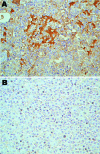Novel picornavirus in Turkey poults with hepatitis, California, USA
- PMID: 21392440
- PMCID: PMC3166023
- DOI: 10.3201/eid1703.101410
Novel picornavirus in Turkey poults with hepatitis, California, USA
Abstract
To identify a candidate etiologic agent for turkey viral hepatitis, we analyzed samples from diseased turkey poults from 8 commercial flocks in California, USA, that were collected during 2008-2010. High-throughput pyrosequencing of RNA from livers of poults with turkey viral hepatitis (TVH) revealed picornavirus sequences. Subsequent cloning of the ≈9-kb genome showed an organization similar to that of picornaviruses with conservation of motifs within the P1, P2, and P3 genome regions, but also unique features, including a 1.2-kb sequence of unknown function at the junction of P1 and P2 regions. Real-time PCR confirmed viral RNA in liver, bile, intestine, serum, and cloacal swab specimens from diseased poults. Analysis of liver by in situ hybridization with viral probes and immunohistochemical testing of serum demonstrated viral nucleic acid and protein in livers of diseased poults. Molecular, anatomic, and immunologic evidence suggests that TVH is caused by a novel picornavirus, tentatively named turkey hepatitis virus.
Figures




References
-
- Snoeyenbos GH, Basch HI. Further studies of virus hepatitis of turkeys. Avian Dis. 1960;3:477–84. 10.2307/1587700 - DOI
-
- Mongeau JD, Truscott RB, Ferguson AE, Connell MC. Virus hepatitis in turkeys. Avian Dis. 1959;3:388–96. 10.2307/1587578 - DOI
-
- Snoeyenbos GH, Basch HI, Sevoian M. An infectious agent producing hepatitis in turkeys. Avian Dis. 1959;3:377–88. 10.2307/1587577 - DOI
Publication types
MeSH terms
Substances
Grants and funding
LinkOut - more resources
Full Text Sources
Other Literature Sources
